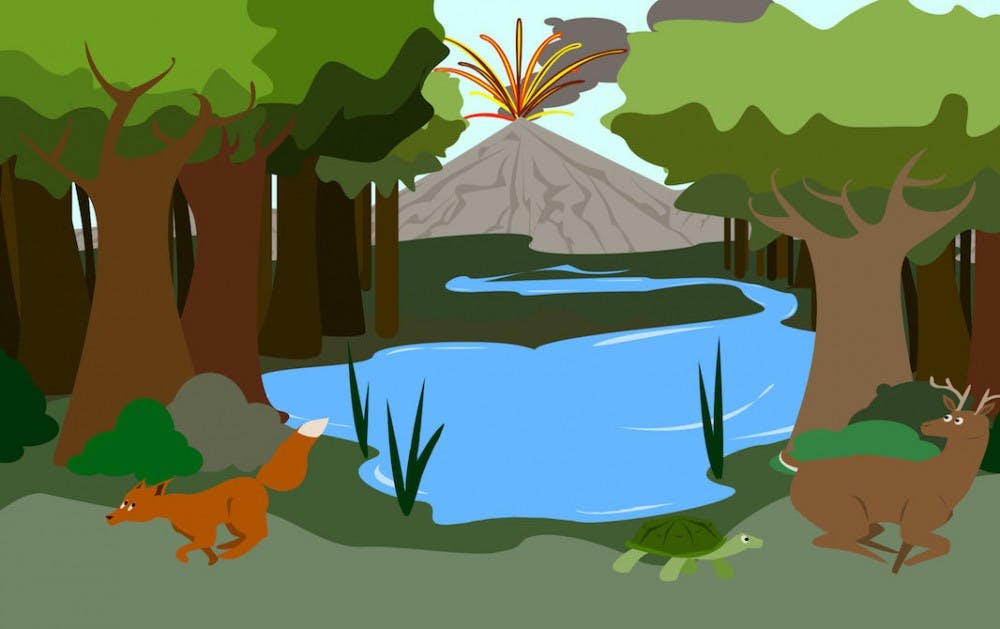ASU researchers in South Africa are studying how humans were able to continue their lives despite a major change in climate 74,000 years ago after the Toba super-volcanic eruption in Indonesia.
Curtis Marean, a professor and associate director at ASU's Institute of Human Origins, is the project director of a research site in the southern coastal town of Pinnacle Point, South Africa.
When Toba exploded and challenged the human species with abrupt climate change, humans still thrived, Marean wrote in a paper published by Nature on March 12.
Marean started his research at Pinnacle Point in South Africa in 1999. He said he had a set of research questions about the origins of modern humans and believed that the southern coast of South Africa was the best target region.
The researchers on site found sentiments of glass shards and began geochemistry work to prove that they were from Toba. When they first looked at the shards under a microscope, the researchers determined that they were volcanic.
By examining the number of shards at the site with three dimensional mapping techniques, the researchers hypothesized that there was no real change in the lifestyle of people who lived there during the time of the eruption. This is due to the dense amount of artifacts left, which indicates that there were no definite periods where people left the area.
“We excavated the sites with very high resolution techniques – every artifact is measured with a laser positioning device that gives us sub-millimeter precision," Marean wrote in an email. "We then looked at the distribution of the artifacts across the input layer of shards."
Marean said that their current techniques of dating have a precision of about ten percent, so the dating for Toba is plus or minus 7,000 years.
"Toba is dated far more precisely, so it provides a way to calibrate our dating at high precision," Marean wrote. "In our paper, we found (shards) at two sites near eachother so those sites were likely made by people from the same social group. That is an absolutely incredible result. That has never been achieved in paleoscience prior to our study."
Erich Fisher, a research scientist with the Institute of Human Origins, helped develop detailed 3-D mapping technologies that can be used at archeological sites around the world. Fisher and his team are using this technology at Pinnacle Point.
“The most common technique that we use is with a machine called a Total Station, and this machine measures angles and distances using lasers," Fisher said. "We can use it to map the location of artifacts, and samples and anything we can find at archeological sites down to centimeter and millimeter accuracies."
Fisher said that while looking at spacial patterns, the specific places where things were located and how all of these elements change over time, researchers can learn how people lived their lives not only decades ago, but also tens of thousands of years ago.
Fisher said they have mapped thousands of artifacts and pieces of bone at this archeological site in South Africa.
"There are no real periods where people had left the site or anything it is a continuous occupation," Fisher said. "You might expect that all of a sudden there might be a gap, and there would be no archeological materials or something like that, but we don't see any evidence like that where it had a major impact on people's lives."
The glass shards that were found in South Africa from the eruption were understood in more depth by comparing the eruption to another that occured in the 1800s from the volcano Mount Tambora. This comparison helped researchers determine how the climate might have changed around the Toba eruption.
Christopher Campisano, an associate professor at the School of Human Evolution and Social Change and research associate at the School of Human Origins, believes that studying events that happened thousands of years ago helps researchers understand where humans come from and how lifestyles have changed over time.
"With the volcanic eruptions, we can observe those today and we can see the process of what happened and the effects that they have and we can ... create hypotheses about ... potential cause and effect in the past," Campisano said. "These modern analogs provide sort of a test case for our hypotheses and you assume that the processes that happen today are the same as the processes that happened in the past, at least in terms of a natural environment."
Reach the reporter at jlmyer10@asu.edu or follow @jessiemy94 on Twitter.
Like The State Press on Facebook and follow @statepress on Twitter.




